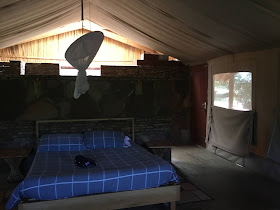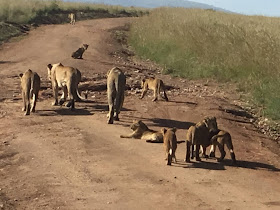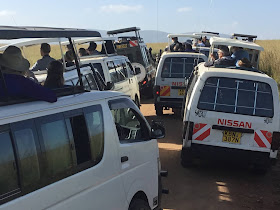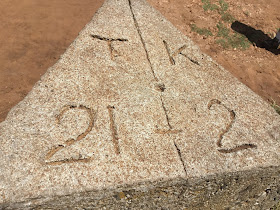We had to wait 5 hours for our connecting flight to Nairobi. On arrival we were met by our driver and transported to our hotel, to rest overnight, before we begin our tour.
After 28hrs on leaving home, it was an early meal and early to bed.
The next day we met our driver/guide, Debit who navigated the very heavy traffic of Nairobi and we made our way to the Masai Mara National Park.
This drive was about 5 hours, we drove through the Rift Valley, the bread basket of Africa.
The great Rift Valley is part of the Afro-Arabian rift system which stretches from Jordan in the north to Mozambique in the south. Nowhere is it more defined than in Kenya where in places, it is as wide as 80km (50miles) across the escarpment walls rising up to 600 metres (2,000feet)
The views from some of these walls are spectacular.
We travelled through the scenic plains towards Narok and the Mara National Reserve.
View of the Rift Valley
Lots of curio shops
After our viewing, we drove down the valley to have a very good cup of Kenyan coffee.
We arrived into our lodgings, which is situated in a conservancy bordering the Masai Mara game reserve.
Mara Sentrim, our accomodation
Glamping style with full amenities.
The pool area.
After we settled in and had lunch, we went on a game drive for 4 hours in the Masai Mara game reserve.
The grass was very long and green, hard to see many animals clearly, we were lucky with the serval cat being on the road.
This serval cat was walking along the road, apparently they are hard to spot, we were lucky to see one, at first we thought it was a leopard, often mistaken for one.We also saw four cheetahs, lying in the grass, we were allowed to go by two cars with the permission of the research team.
The four cheetahs
Crown primrose birds.
A lone giraffe
A Masai Mara sunset, gorgeous on a Valentine’s Day.
The Masai Mara lies along the border of Tanzania, it is bisected by the Mara River and boarded on the western boundary by a spectacular escarpment. The film “Out of Africa” was filmed in this area.
The Mara is an area of 2700sq km (690sq.miles) and is the home of the greatest variety and largest number of wild animals in Kenya.
It is also the northern extension of Tanzania’s famous Serengeti national parks and the animals wander freely across man-made borders.
Our abode for the night
Part of the big five, we were luck enough to see 6 lioness and 7 cubs, just dawdling along the road, so excited to watch them, they were not scared of the cars. Everyone rushed to the spot to catch a look, I have several photos of course as well as a video, too see them this close was a bonus.
All the safari vehicles, word gets out very quickly.
A Masai giraffe, they are browner than the South African giraffe.
Leopard in the tree, this was an adventure to get this photo, let me begin an explanation, not sure how it was spotted, but it was in a tree in the distance, to get closer, money had to change hands and two cars at each time were allowed a photo stop. In the Masai Mara National Park, a heavy fine applies if you go off the tracks and make your own tracks. To get close to the leopard we had to cross a large embankment!!!!, here lies the drama....... we got stuck on the embankment, to get off after several attempts, the help of other game drivers, we had to pushed with a big bull bar to try and go forward, after several rams and skidding of tyres etc, we event
gotta free, I might add we were the talk of the park.
Distance described to both countries.
A hippos jaw on the Mara River
Our ranger guide Will, who took us on an escorted tour of the Mara River.
The Mara River where the migration happens every year in July. This is where they cross. During the migration the whole reserve may be dotted with herds of wildebeest. A count during migration in the 80’s revealed over a million wildebeest, half a million gazelles and over 200,000 zebra residents in the reserve at any one time. In the crossing of the Mara River, which flows very fast, the loss of animals can be up to 2,000 or more and the river just stinks with dead animals. The wildebeest usually follows the zebras. They cross to give birth and return to the greener grass in September /October.
The Mara River
Hippos live along this river as well as crocs.
See how fast the river flows.
The Mara River signpost.
The two Tony’s discussing the river and crossing.
Huge crocs in the river, they feed on all the carcasses.
The river, how fast it flows.
Hippos in the river.
This photo was captured by a professional photographer in Masai Mara reserve, one of the cheetahs we seen of the four, helped bring down a topi on the 20th February.
We had two wonderful days in the Masai Mara Game Park, very different landscape to Kruger National Park. More adventures to follow with our visit to the Masai Mara village.



































No comments:
Post a Comment